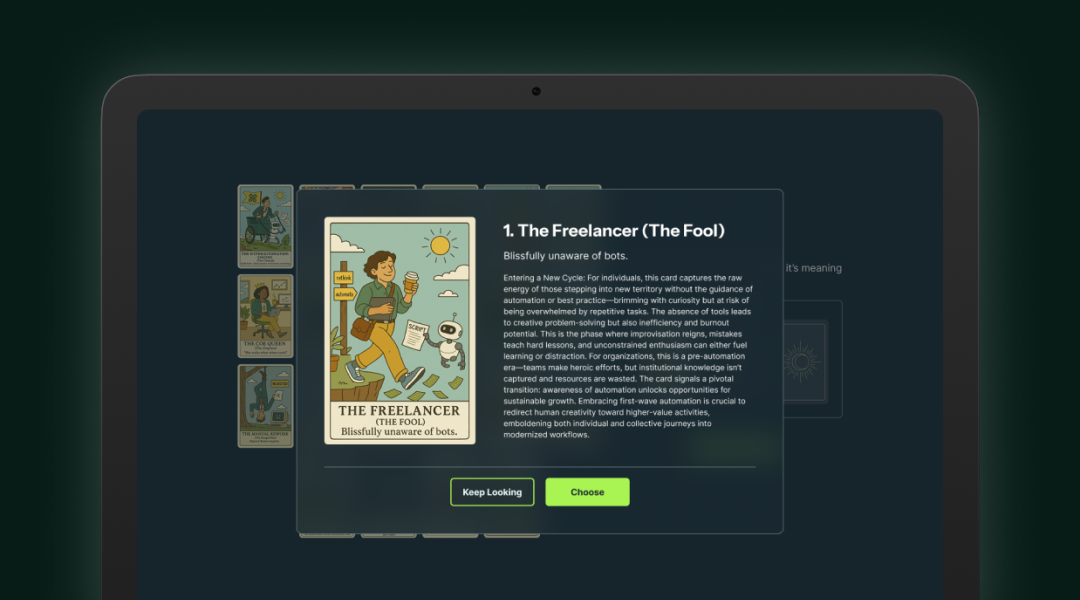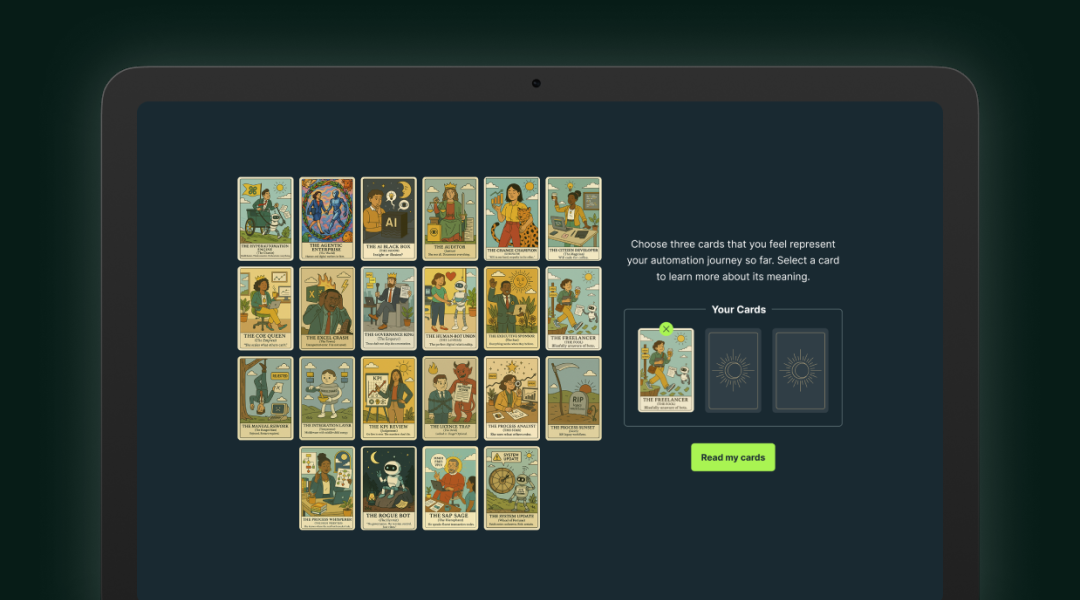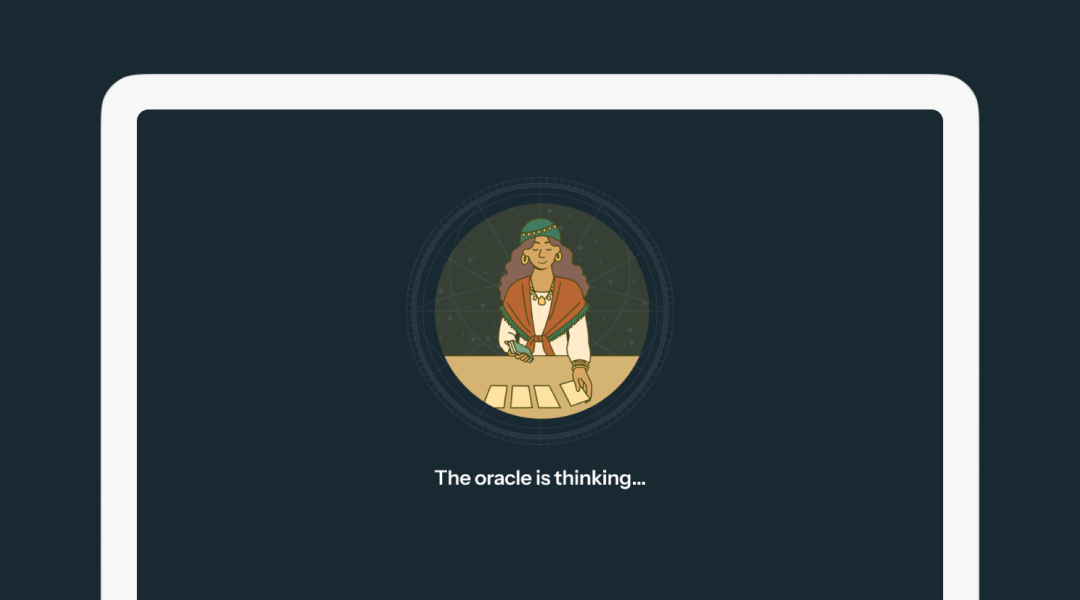Case Study
How We Brought The Ashling Oracle to Life at FUSION 25

Once again, UiPath’s FUSION conference has been one of the landmark events of the year for the Agentic AI and Automation community. This year’s event was shaped by an almost perfect mix of excitement about Agentic Automation and a lack of clarity around what it actually looks like in practice.
What’s clear is that people are hungry to learn more and find ways to implement these technologies to drive business outcomes, but without a trusted partner, it can be a challenge to find applicable use cases that create impact.
In the spirit of the conference, we decided to infuse our own event strategy with a healthy dose of AI and automation to create The Ashling Oracle — an interactive web application built on the Microsoft Power Platform, integrated with ChatGPT and HubSpot’s Smart CRM. We think it’s a great example of how the right tools and strategy can come together to create unique point solutions and great outcomes.

It started with a swag idea
What if we created a Tarot-inspired deck of cards that poked fun at some of the most common topics and challenges people are facing today, rooted in real truths we’ve lived through with hundreds of teams across industries like manufacturing, energy, finance, and healthcare? Wouldn’t that be a cool giveaway? We thought so.
The cards were a hit at global events, so we knew that we wanted to leverage them in some way as part of our presence at FUSION this year. The puzzle was how to create a fun, interactive experience that involved them in some way and took advantage of AI and automation, tying it all back to the core of what Ashling does.
We decided to create a “fortune teller” style experience by combining a low-code app build with AI fine-tuning. Attendees could explore the cards, select three representing their current automation challenges and opportunities, and receive a personalized interpretation.
The next step was to decide what tooling we would use to bring it all together.
The technology behind the Oracle
The first decision we had to make was what technology to use to develop the actual visitor-facing application — and that was an easy choice for us, since we knew the capability and flexibility of the Microsoft Power Platform would be more than up to the task. While this implementation was a little bit different than our usual enterprise-grade solutions, our team felt excited to try something new.
Now that the front end experience was in place, the next step was creating the right training materials and custom instructions to power our TarotGPT, built with OpenAI tools, and then leveraging the Responses API to connect the application with the GPT.
That gave us a fun, easy to use application that could create unique fortunes for users by combining information about their industry and role with raw material about the possible meanings of the cards and their relationships to each other. It was the perfect activation for the fun, excited energy in Las Vegas at the event, and let us showcase what we do best in a lighthearted way.
The final part of the work involved building out marketing automations in the HubSpot platform that would enable us to email each user a copy of their unique fortune in a polished HTML email template, completing the experience.

Refining the experience
At Ashling, we’re focused on creating great outcomes, and that often requires some creative problem solving to achieve. For the Ashling Oracle, we worked through the entire user experience from end to end to deliver the magic of the cards.
On the user experience front, we made small but important adjustments like increasing the time it took to deliver a response by a few seconds with a “The Oracle is Thinking” screen to heighten users' anticipation. When the card descriptions proved too long for testers to scan and absorb, we carefully shortened them on the front end, while still leveraging the full descriptions for the GPT. Testing and fine-tuning our work is always a critical step in the process.
Likewise, when working with the AI to create the source material and custom prompts that would deliver agentic destinies, there was a substantial amount of experimentation and fine-tuning calibration required to create consistently engaging, hallucination-free responses. Though the subject matter was a little less serious than our usual fare, Ashling’s AI experts were able to engineer exactly the right prompt thanks to our experience with AI tools across many projects.
Uncovering new use cases
Early on at the event, a lot of visitors to our booth were surprised to find us offering tarot-style card readings, and there was a fair amount of confusion — what did it have to do with automation?
Once the first brave few dove into the experience, they immediately realized the real world applications of a combination of AI and low-code applications to create many different kinds of solutions. As they shared their enthusiasm with other attendees, more and more people showed up to see what it was all about.
The entire project was a great example of how many possible use cases there are for any given technology, let alone combinations of powerful tools — you might say that your imagination is the only limit.
Our team specializes in this kind of solution-first thinking when it comes to Intelligent Automation, working to understand business needs and context and then bringing something amazing to life. Parody tarot cards aside, this activity leverages two tech capabilities that we typically use in designing full end-to-end solutions for our clients.
Whether we’re using GenAI to summarize partner and contract summaries for this FinTech, or designing and building the Queue management app required for BA's to effectively trigger, track and monitor Intelligent Document Processing jobs, we help teams achieve their goals.
If you’ve got an idea that you want to bring to life, but haven’t figured out how to make it happen, reach out to Ashling today to speak with one of our Intelligent Automation experts and start creating a plan of action.



